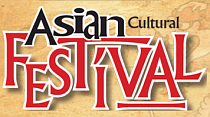-
(单词翻译:双击或拖选)
New York
25 April 2007
The Asian Cultural Festival celebrates and explores the multi-cultural, multi-lingual, and multi-dynamic Asian-American experience. Where better to host such a festival than in Queens, New York - the most ethnically1 diverse county in the United States. From VOA's New York Bureau, Mona Ghuneim has the story.
 |
The weeklong festival, being held for a second year in a row, provides a stage for Asians and Asian-Americans to express their differences, and similarities.
Vivian Chiu, who grew up in Taiwan, is the festival's director. She says the events are different in content, execution and even technical direction. But they share the same artistic3 vision, to break stereotypes4 and move from the confines of what is expected. Asian performance art, she says, is not the dragon-ladies, submissive women, and Kung-fu fighters often portrayed5 in films and advertisements.
"In each event, there's collaborating6 efforts between artists of different cultural backgrounds," she said. "For Ping Chong's 'Undesirable7 Elements', we have a [Chinese] poet, we have a Korean trans-gendered woman, and also we have an Indian business founder8. So they come from very different, diverse cultural backgrounds and also different industries."
Chiu selected a variety of acts ranging from contemporary, Eastern-infused dance by a Taiwanese troupe9 to a performance of spoken word, hip-hop and acoustic10 soul by a group of Asian-American artists.
Ping Chong's theatrical11 piece, "Undesirable Elements," is a compelling compilation12 of real people telling stories of cultural identity.
Here a Korean trans-gendered woman relates how she and her brother, adopted by an American couple when they were two young boys, were often misunderstood.
MAN: "1970 - December 7, 1970"
KOREAN WOMAN: "My brother and I are the only non-white children in our school, and in our neighborhood. Most families in our community have relatives who served in World War II, like our father did. Every year I dread13 Pearl Harbor Day. Every year, other children will taunt14 us, call us names and throw things at us. The fact that we're Korean, and not Japanese, does not matter."
The artists and organizers of the festival say they want audiences to experience the broad spectrum15 of Asian art and culture.
Rohi Mirza Pandya is a writer and director of South Asian heritage. She is the producer of 7-Eleven Convenience Theater. The show is a series of seven eleven-minute plays set in a convenience store. Pandya says a lot of Americans have only one image of the convenience store owner, an Indian or Chinese man with a funny accent. The show, she says, turns stereotypes on their heads.
"I think when you see images in the media or on television of store clerks, they're always just one-dimensional, whereas we're doing stories that have depth and these characters have a whole story behind them," she explained. "So you don't really see that anywhere else."
The festival's location, at the Queens Theatre in the Park, is a key part of the program. Just as diverse and dynamic as the performances themselves, the borough16 of Queens is home to one of the most ethnically varied17 populations in the world. Almost half of its more than two million residents are foreign-born and about 138 languages are spoken, making Queens the most multi-lingual place in the United States.
Jeffrey Rosenstock, the executive director of the theatre, says the festival fills a gap in Queens, where about 19 percent of the population is Asian.
"We looked at the different demographics of the borough and the changing demographics of the borough and really felt that we wanted to reflect that, not just with the artists on our stage, but the audiences," he said. "We are a mainstream18 institution that has made a commitment to embrace the different cultures that represent our city and especially our borough."
Rosenstock says he hopes the festival brings the Asian and non-Asian communities together. Offering them a selection of show tunes19 sung by Asians who have performed on Broadway certainly seems like an entertaining way to build that bridge.
 收听单词发音
收听单词发音
1
ethnically

|
|
| adv.人种上,民族上 | |
参考例句: |
|
|
|
2
tenor

|
|
| n.男高音(歌手),次中音(乐器),要旨,大意 | |
参考例句: |
|
|
|
3
artistic

|
|
| adj.艺术(家)的,美术(家)的;善于艺术创作的 | |
参考例句: |
|
|
|
4
stereotypes

|
|
| n.老套,模式化的见解,有老一套固定想法的人( stereotype的名词复数 )v.把…模式化,使成陈规( stereotype的第三人称单数 ) | |
参考例句: |
|
|
|
5
portrayed

|
|
| v.画像( portray的过去式和过去分词 );描述;描绘;描画 | |
参考例句: |
|
|
|
6
collaborating

|
|
| 合作( collaborate的现在分词 ); 勾结叛国 | |
参考例句: |
|
|
|
7
undesirable

|
|
| adj.不受欢迎的,不良的,不合意的,讨厌的;n.不受欢迎的人,不良分子 | |
参考例句: |
|
|
|
8
Founder

|
|
| n.创始者,缔造者 | |
参考例句: |
|
|
|
9
troupe

|
|
| n.剧团,戏班;杂技团;马戏团 | |
参考例句: |
|
|
|
10
acoustic

|
|
| adj.听觉的,声音的;(乐器)原声的 | |
参考例句: |
|
|
|
11
theatrical

|
|
| adj.剧场的,演戏的;做戏似的,做作的 | |
参考例句: |
|
|
|
12
compilation

|
|
| n.编译,编辑 | |
参考例句: |
|
|
|
13
dread

|
|
| vt.担忧,忧虑;惧怕,不敢;n.担忧,畏惧 | |
参考例句: |
|
|
|
14
taunt

|
|
| n.辱骂,嘲弄;v.嘲弄 | |
参考例句: |
|
|
|
15
spectrum

|
|
| n.谱,光谱,频谱;范围,幅度,系列 | |
参考例句: |
|
|
|
16
borough

|
|
| n.享有自治权的市镇;(英)自治市镇 | |
参考例句: |
|
|
|
17
varied

|
|
| adj.多样的,多变化的 | |
参考例句: |
|
|
|
18
mainstream

|
|
| n.(思想或行为的)主流;adj.主流的 | |
参考例句: |
|
|
|
19
tunes

|
|
| n.曲调,曲子( tune的名词复数 )v.调音( tune的第三人称单数 );调整;(给收音机、电视等)调谐;使协调 | |
参考例句: |
|
|
|















